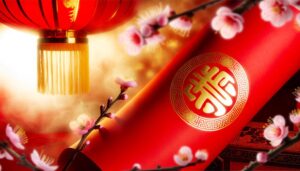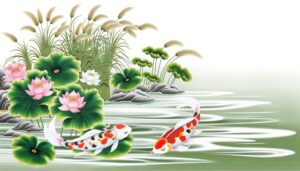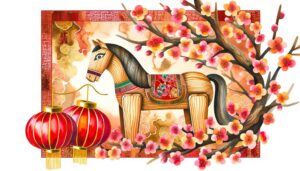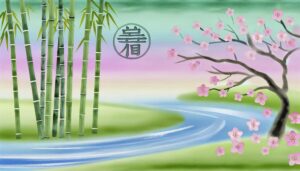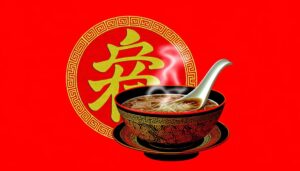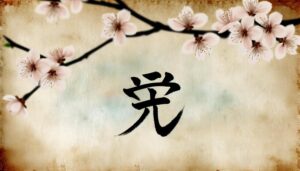What Are Chinese Symbols for Happy New Year?
The Chinese symbol for 'Happy New Year' (福, fú) encapsulates centuries of cultural heritage and is integral to Chinese New Year celebrations. Originating during the Zhou Dynasty, this character, often linked to happiness and good fortune, integrates Daoist, Confucian, and Buddhist ideologies.
Its depiction on red paper became prevalent in the Tang Dynasty, symbolizing prosperity, longevity, and harmony. Contemporary festivities maintain its presence, blending traditional calligraphy with modern digital expressions, and underscoring its enduring cultural resonance.
Exploring beyond this character reveals the deeper essence of its historical roots and modern adaptations.
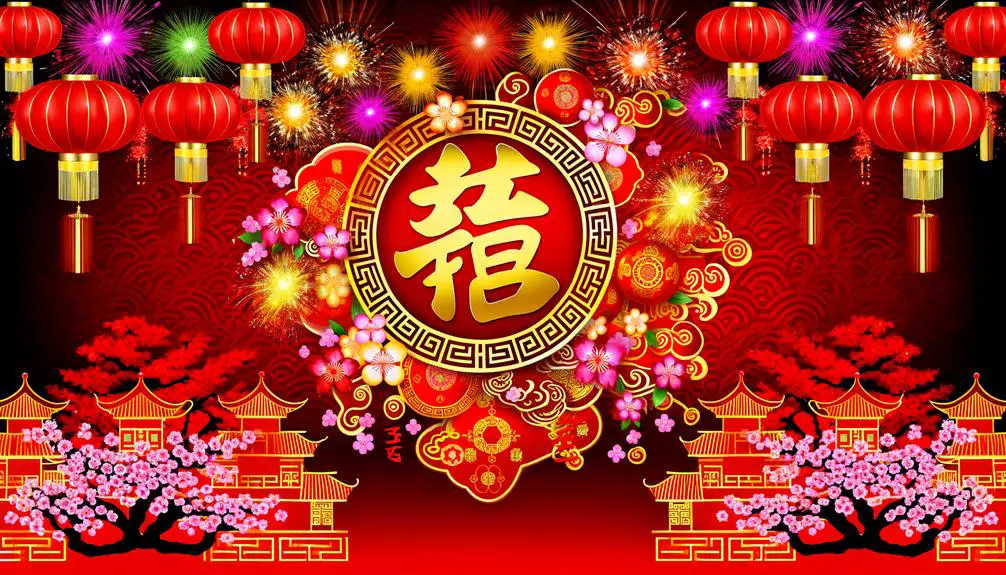
Key Takeaways
- The Chinese symbol for 'Happy New Year' is 新年快乐 (xīn nián kuài lè).
- The character 福 (fú) meaning 'happiness' or 'good fortune' is often used in New Year decorations.
- Red paper cutouts and couplets featuring the symbol are traditional New Year decorations.
- Modern celebrations incorporate digital greetings and social media posts featuring the symbol.
- The symbol embodies prosperity, longevity, and harmony in New Year festivities.
Historical Background
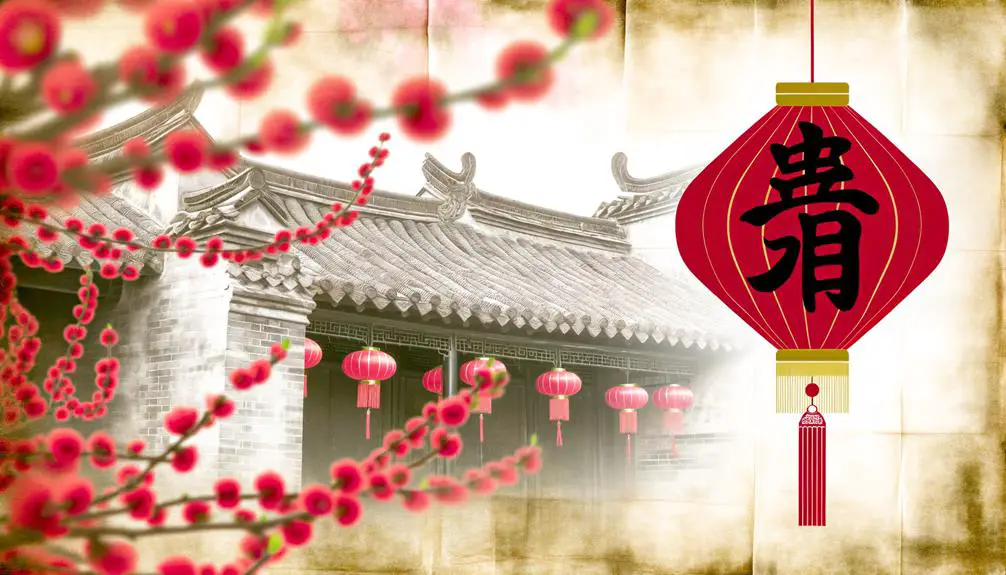
The historical background of the Chinese symbol for 'Happy New Year' is deeply rooted in ancient traditions and cultural practices that date back thousands of years to the earliest dynasties of China.
Originating during the Zhou Dynasty (1046-256 BCE), the character 福 (fú), meaning 'happiness' or 'good fortune,' was prominently used in New Year festivities. The evolution of this symbol reflects a synthesis of Daoist, Confucian, and Buddhist influences, which collectively shaped its present-day form.
Initially inscribed on bamboo and silk, the symbol shifted to red paper during the Tang Dynasty (618-907 CE), symbolizing prosperity and warding off evil spirits. This historical trajectory underscores the enduring significance and the meticulous cultural heritage embedded in the Chinese New Year celebration.
Cultural Importance
The cultural importance of the Chinese symbol for 'Happy New Year' is deeply rooted in historical significance, carrying symbolic meanings that reflect prosperity, longevity, and harmony.
This emblem is not merely a decorative artifact but an integral element in modern celebrations, bridging ancient traditions with contemporary practices.
Through its multifaceted representations, the symbol encapsulates the collective aspirations and cultural ethos of Chinese society during the festive season.
Historical Significance
Historically, how has the Chinese symbol for 'Happy New Year' embodied the cultural values and traditions that are integral to Chinese society?
The symbol, often rendered as '新年快乐' (xīn nián kuài lè), reflects a deep-seated reverence for renewal and communal harmony.
Rooted in ancient agrarian practices, the New Year was a time to honor deities and ancestors, ensuring prosperity and protection. The character '新' (xīn) signifies new beginnings, while '年' (nián) denotes the cyclical passage of time, emphasizing continuity.
'快乐' (kuài lè), meaning happiness, encapsulates the collective aspiration for joy and well-being.
This linguistic construct is more than a greeting; it is a manifestation of societal ideals, encompassing familial unity, reverence for tradition, and hope for a prosperous future.
Symbolic Meanings
Embodying a rich tapestry of cultural significance, the Chinese symbol for 'Happy New Year' (新年快乐) serves as a profound reflection of collective aspirations and societal values. This emblem encapsulates a multitude of symbolic meanings, deeply rooted in Chinese traditions:
- Prosperity and Wealth: Wishing for financial success in the coming year is a cornerstone of the festivity.
- Health and Longevity: Emphasizing well-being and a long, fruitful life underscores the importance of family and community.
- Harmony and Peace: Promoting social cohesion and tranquility, this wish fosters a sense of shared destiny.
These elements reflect the broader cultural ethos, wherein the New Year serves as a pivotal moment for renewal and the reinforcement of communal bonds.
Modern Celebrations
In contemporary society, celebrating the Chinese New Year has evolved to incorporate both traditional customs and modern innovations, reflecting the dynamic interplay between heritage and globalization. Traditional practices such as lion dances, red envelope exchanges, and family reunions are now complemented by contemporary elements like virtual festivities, online shopping for festival goods, and social media engagement.
This fusion underscores the cultural importance of the festival, maintaining its symbolic significance while adapting to technological advancements and global interconnectedness. The Chinese diaspora worldwide also plays a pivotal role, fostering cross-cultural exchanges that enrich the celebration's global footprint.
Consequently, the essence of Chinese New Year endures, symbolizing prosperity, unity, and renewal in both local and international contexts.
Symbolic Meaning
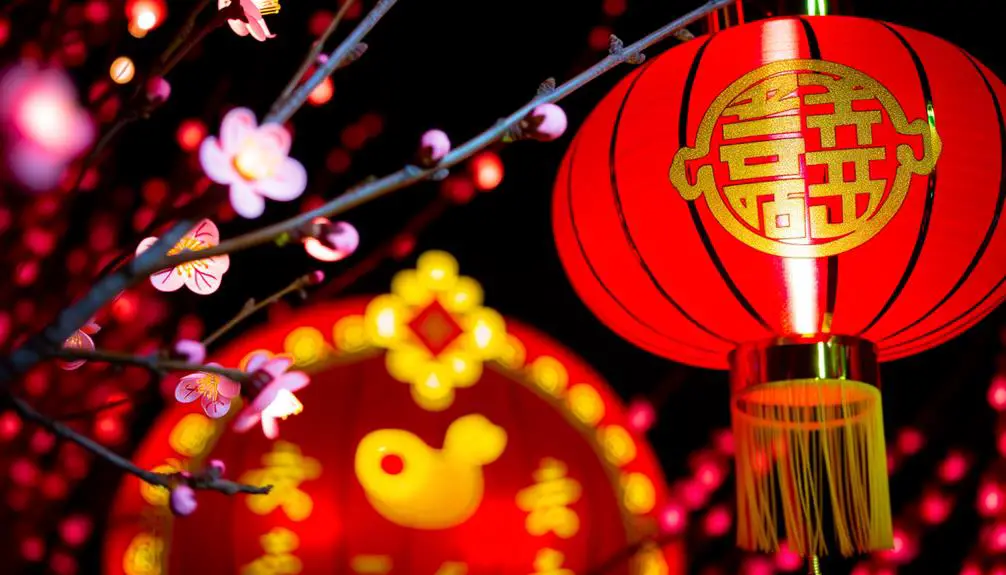
The symbolic meaning of the Chinese character for 'Happy New Year' encompasses a rich tapestry of cultural significance, historical origins, and modern usage.
Rooted in ancient traditions, this symbol has evolved from its early inscriptions to its contemporary representations, reflecting the enduring values and customs of Chinese society.
Today, it serves not only as a festive greeting but also as a profound emblem of hope, renewal, and communal unity.
Cultural Significance
Within the rich tapestry of Chinese culture, the symbol for 'Happy New Year' carries profound implications that extend beyond mere festive greetings, encapsulating wishes for prosperity, longevity, and harmony in the coming year. This symbolic expression is deeply intertwined with cultural values and traditions, reflecting a collective aspiration for well-being and societal cohesion.
The cultural significance is manifold:
- Prosperity (富贵): The symbol embodies wishes for economic success and material abundance.
- Longevity (长寿): It signifies a desire for extended life and good health.
- Harmony (和谐): The symbol promotes unity and peaceful coexistence within communities.
Understanding these layers of meaning provides insight into the societal priorities and philosophical underpinnings of Chinese celebrations.
Historical Origins
Examining the historical origins of the Chinese symbol for 'Happy New Year' reveals a rich tapestry of ancient traditions and evolving linguistic expressions.
Rooted in centuries-old customs, the phrase '新年快乐' (xīn nián kuài lè) combines '新年' (xīn nián), denoting 'New Year,' with '快乐' (kuài lè), signifying 'happiness.' This symbolic amalgamation underscores a cultural emphasis on renewal and joy.
Ancient Chinese society placed immense importance on the New Year as a time to honor ancestors, cleanse homes, and invite prosperity. The character '新' (xīn) conveys notions of novelty and rejuvenation, while '快乐' (kuài lè) encapsulates a universal human desire for joy.
These characters collectively embody the essence of communal well-being and auspicious beginnings.
Modern Usage
In contemporary Chinese culture, how does the symbol for 'Happy New Year' (新年快乐) continue to encapsulate both traditional values and modern aspirations for joy and prosperity?
The symbol 新年快乐 is more than a greeting; it signifies the harmonious blend of enduring cultural heritage and present-day ambitions.
As urbanization and globalization influence daily life, the phrase retains its multifaceted significance through:
- Cultural Preservation: Upholding ancient customs and rituals during the Spring Festival.
- Social Connectivity: Serving as a linguistic bridge that fosters communal bonds.
- Personal Aspirations: Reflecting individual hopes for success, health, and happiness in the upcoming year.
Thus, 新年快乐 remains a profound expression, harmonizing historical reverence with contemporary dynamism.
Traditional Calligraphy
Traditional Chinese calligraphy, an art form with millennia of history, embodies the cultural essence and aesthetic principles that are vividly expressed in the creation of characters for auspicious phrases, such as 'Happy New Year.'
This revered practice engages a harmonious blend of brush technique, ink flow, and compositional balance, reflecting Confucian ideals of discipline and Daoist spontaneity. The characters for 'Happy New Year' (新年快乐) are meticulously crafted to convey not only well-wishes but also the calligrapher's inner spirit and mastery.
Each stroke carries symbolic weight, where the elegance of line and form embodies blessings of prosperity and joy. Therefore, traditional calligraphy serves as both a visual and cultural conduit, preserving and transmitting heritage through its intricate artistry.
Modern Interpretations
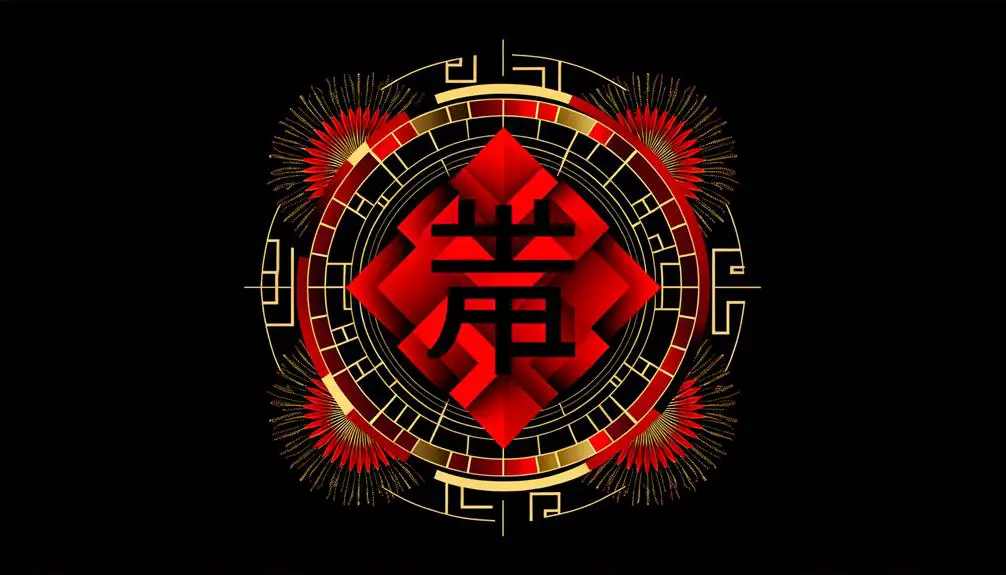
In the contemporary cultural landscape, the Chinese symbol for 'Happy New Year' has evolved beyond its traditional roots to embody a broader spectrum of meanings and artistic expressions.
This transformation is evident in its integration into various modern media, including digital art, fashion, and public installations, reflecting the dynamic interplay between heritage and innovation.
Such reinterpretations not only retain the symbol's auspicious connotations but also enhance its relevance in a rapidly globalizing world.
Contemporary Cultural Significance
Modern interpretations of the Chinese symbol for 'Happy New Year' encompass a blend of traditional values and contemporary cultural practices, reflecting the dynamic evolution of Chinese society. This symbol, deeply rooted in historical significance, now finds relevance in various modern contexts:
- Digital Communication: The symbol is widely used in digital greetings, social media posts, and instant messaging, bridging geographical gaps.
- Commercial Branding: Companies leverage the symbol in marketing campaigns to resonate with cultural sentiments and promote products during the festive season.
- Cultural Preservation: Educational initiatives and community events utilize the symbol to teach younger generations about traditional customs, ensuring cultural continuity.
These modern applications underscore the symbol's enduring importance and adaptability in a rapidly changing world.
Artistic Expressions Today
The enduring relevance of the Chinese symbol for 'Happy New Year' extends into contemporary artistic expressions, where it is reimagined through various modern mediums that reflect a synthesis of historical reverence and innovative creativity.
Artists today leverage digital platforms, street art, and multimedia installations to reinterpret this traditional emblem. By employing augmented reality, graphic design, and interactive exhibits, they bridge the gap between ancient symbolism and modern aesthetics.
These artistic endeavors not only preserve the cultural essence of the symbol but also imbue it with new meanings that resonate with younger generations.
This dynamic interplay between tradition and modernity exemplifies how cultural symbols evolve, ensuring their continuous relevance in an ever-changing world.
Common Variations
Several variations of the Chinese symbol for 'Happy New Year' exist, each reflecting regional dialects, historical influences, and calligraphic styles. The most prevalent form is the simplified '新年快乐' (xīn nián kuài lè), widely used in mainland China.
- Traditional Characters:
In regions like Taiwan and Hong Kong, '新年快樂' (xīn nián kuài lè) features traditional characters, preserving historic script forms.
- Cultural Nuances:
Variations such as '恭喜发财' (gōng xǐ fā cái) emphasize prosperity and are popular in southern China.
- Dialectal Differences:
Local dialects influence expressions like '賀新年' (hè xīn nián) in certain areas, enriching linguistic diversity.
These variations illustrate the dynamic nature of Chinese New Year greetings, shaped by linguistic, cultural, and historical contexts.
Usage in Decorations

Building upon the rich tapestry of variations, the Chinese symbol for 'Happy New Year' manifests prominently in various decorative forms during the festive season, reflecting both traditional and contemporary aesthetics.
Traditionally, the symbol is intricately crafted onto red paper cutouts, lanterns, and couplets, which are then prominently displayed on doors and windows to invite prosperity and good fortune.
Contemporary decorations incorporate modern materials such as LED lights and digital displays while retaining the cultural essence. The symbol's vibrant presence in public spaces, homes, and businesses underscores its cultural significance, acting as a visual herald of renewal and auspicious beginnings.
This, it serves as both an artistic expression and a medium of cultural transmission, bridging past traditions with modern interpretations.
Symbol in Art
In myriad artistic expressions, the Chinese symbol for 'Happy New Year' serves as a powerful motif, encapsulating both the cultural heritage and aesthetic principles that define Chinese art. This symbol finds its place in various artistic forms, each elucidating unique aspects of Chinese culture:
- Calligraphy: The meticulous strokes of calligraphy not only convey the message but also embody the spiritual essence of the celebration.
- Painting: Traditional Chinese paintings often integrate this symbol, merging visual beauty with cultural significance.
- Ceramics: Porcelain and pottery pieces frequently feature the symbol, demonstrating the fusion of utility and artistic expression.
These artistic representations underscore the emblem's role in perpetuating cultural identity, while seamlessly blending tradition with artistic innovation.
Festive Celebrations
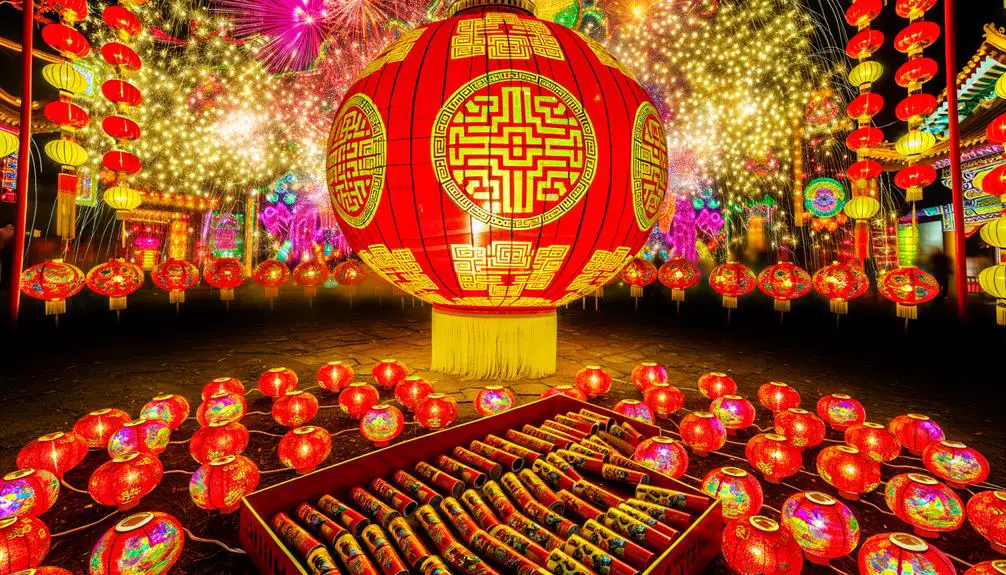
The Chinese symbol for 'Happy New Year' plays a central role in festive celebrations, manifesting in various rituals and customs that highlight the rich cultural tapestry of the Chinese New Year.
This emblem is omnipresent, adorning homes, shops, and public spaces, symbolizing prosperity and good fortune. Red paper cutouts featuring the symbol are often displayed on doors and windows to ward off evil spirits. Additionally, it appears prominently in calligraphic scrolls and traditional New Year paintings, reinforcing cultural continuity.
During family gatherings, the symbol is integrated into offerings and decorations, fostering a sense of unity and shared heritage. Each of these practices underscores the symbol's pivotal function in the communal and spiritual dimensions of Chinese New Year festivities.
Influence on Other Cultures
Cross-cultural exchange has greatly amplified the reach and resonance of the Chinese symbol for 'Happy New Year', embedding it within diverse cultural frameworks and celebrations beyond China. This symbol's pervasive influence can be attributed to several factors:
- Globalization: Increased interconnectedness has facilitated the dissemination of Chinese cultural elements, including the New Year symbol, across continents.
- Cultural Festivals: Multicultural events often incorporate the Chinese 'Happy New Year' symbol, reflecting a blend of traditions and mutual appreciation.
- Media Proliferation: Digital media platforms and international broadcasting have played pivotal roles in popularizing this symbol, making it a recognizable emblem in global holiday celebrations.
These factors underscore the symbol's dynamic role as a cultural bridge, fostering understanding and unity across disparate societies.
Learning the Symbol
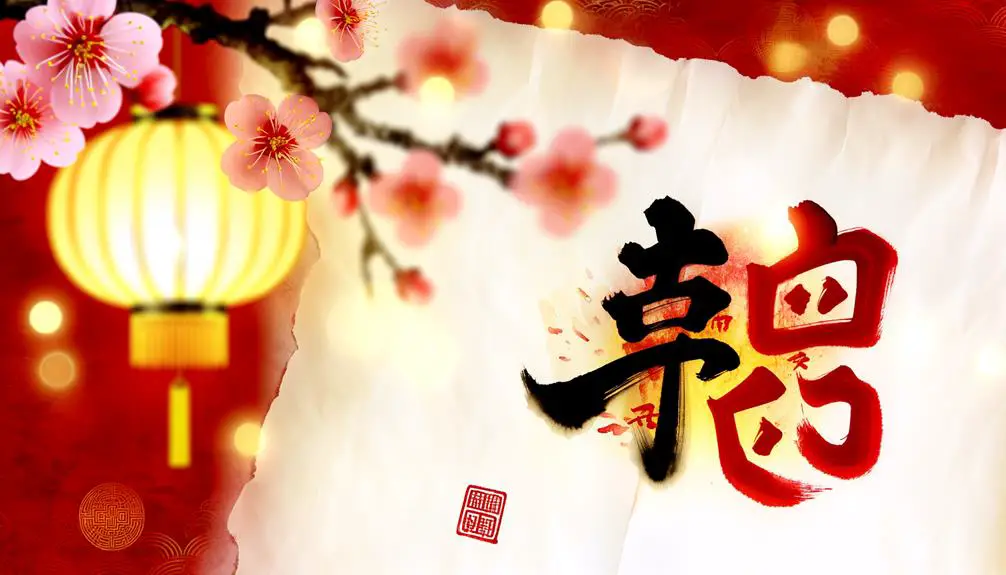
As the Chinese symbol for 'Happy New Year' continues to gain international prominence through cultural exchanges, understanding its composition and meaning becomes increasingly important for those wishing to engage deeply with this aspect of Chinese heritage.
The symbol comprises the characters 新年快乐 (xīn nián kuài lè), where 新 (xīn) means 'new', 年 (nián) signifies 'year', 快 (kuài) translates to 'happy', and 乐 (lè) denotes 'joy'.
This phrase embodies the essence of renewal and festivity intrinsic to the Lunar New Year celebrations. Mastery of this symbol not only reinforces linguistic skills but also enhances cultural appreciation, providing a nuanced comprehension of the traditions and values that underpin this globally recognized festivity.
Conclusion
The Chinese symbol for 'Happy New Year' encapsulates a rich tapestry of historical significance, cultural reverence, and artistic expression.
Importantly, during the Chinese New Year, approximately 1.4 billion people engage in the tradition of displaying this symbol, emphasizing its widespread cultural resonance.
The evolution from traditional calligraphy to modern interpretations underscores its dynamic nature.
This symbol not only adorns festive celebrations but also influences various art forms and extends its cultural impact globally, highlighting its enduring importance.

